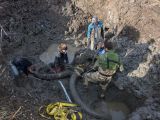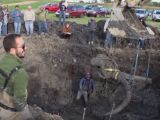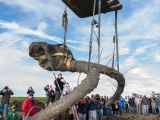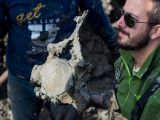Earlier this week, a farmer in Michigan chanced to come across part of a mammoth skeleton in a field not far from the city of Ann Arbor.
At first, the farmer and property owner James Bristle assumed that they had found a dinosaur. “We didn't know what it was, but we knew it was certainly a lot bigger than a cow bone,” James Bristle confessed in an interview.
It wasn't until a team of University of Michigan paleontologists got to work pulling the remains from the ground that it became obvious the skeleton actually belonged to a mammoth that lived in the area 11,700 to 15,000 years ago.
With the help of an excavator who agreed to donate their time, the University of Michigan researchers managed to recover the ancient animal's skull, its long tusks, a pelvis bone, shoulder blades and even a few vertebrae and ribs.
The millennia-old bones only account for about 20% of the mammoth's skeleton. All the same, paleontologists say the find most definitely trumps the scattered skeletal fragments that have so far been discovered in Michigan.
“Most of the mammoth finds in Michigan are not as complete as the remains uncovered by the University of Michigan team,” researcher Daniel Fisher commented on this chance discovery in an interview.
It looks like the mammoth was somebody's dinner
Having examined the bones, the team concluded that they belong to an adult male. What's interesting is that, by the looks of it, the animal became somebody's dinner after its death. More precisely, evidence indicates that early humans in the region fed on it.
Right next to one of the tusks, the researchers found a small stone flake that our ancestors probably used to cut chunks of meat from the dead animal.
Then, three boulders about the size of basketballs found next to the animal's skeleton suggest that, after what must have been a hearty meal, the mammoth carcass was dumped in a pond for safe-keeping and anchored to make sure it wouldn't rise to the surface.
“We think that humans were here and may have butchered and stashed the meat so that they could come back later for it,” said paleontologist Daniel Fisher.
This hypothesis is backed up by the fact that, when they were unearthed, the animal's vertebrae weren't simply scattered around but were instead neatly arranged in their proper anatomical sequence, as if somebody had cut this part of the body and then hidden it.
To confirm that early humans in this corner of the world did in fact feed on this mammoth, the researcher team must wash the bones and inspect them for cut marks.
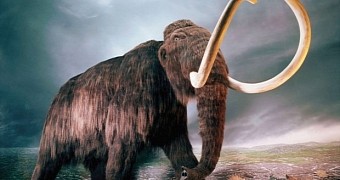
 14 DAY TRIAL //
14 DAY TRIAL // 

